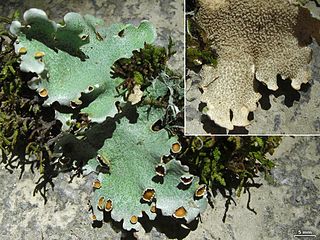
Roccella is a genus of 23 species of lichens in the family Roccellaceae. The genus was circumscribed by Swiss botanist Augustin Pyramus de Candolle in 1805, with Roccella fuciformis as the type species.

Leptogium is a genus of lichen-forming fungi in the family Collemataceae. It has about 110 species. Species formerly classified under Leptogium have since been divided among the genera Leptogium, Pseudoleptogium, and Scytinium. Leptogium lichens are predominantly found on tree bark or soil, often among mosses, and sometimes on rocks in moist environments.
Punctelia colombiana is a species of corticolous (bark-dwelling) and foliose (leafy) lichen in the family Parmeliaceae. It is found in South America.

Punctelia graminicola is a species of foliose (leafy) lichen in the family Parmeliaceae. It grows on rocks, and, less frequently, on bark in North America, South America, and East Africa. It has a blue-grey thallus measuring up to about 15 cm (6 in), covered with tiny pores called pseudocyphellae. Sometimes the lichen forms small lobes that project out from the surface. Fruiting bodies are uncommon in this species; if present, they resemble small cups with a brown internal disc measuring 3–10 mm (0.1–0.4 in) in diameter. A lookalike species, Punctelia hypoleucites, is not readily distinguishable from Punctelia graminicola by appearance or habitat alone; these species can only be reliably differentiated by examining the length of their conidia.
Sticta atroandensis is a species of foliose lichen in the family Peltigeraceae. It is found in the Colombian Andes.
Sticta viviana is a species of corticolous (bark-dwelling), foliose lichen in the family Peltigeraceae. It is found in Colombia, where it grows on the branches and twigs of shrubs and treelets in high-elevation páramo habitat.
Leptogium acadiense is a species of corticolous (bark-dwelling), foliose lichen in the family Collemataceae. Found in northeastern North America, it was formally described as a new species in 2016 by James Hinds, Frances Anderson, and James Lendemer. The species epithet refers to the Acadian region of eastern North America, where the lichen seems to be most common.
Pertusaria albineoides is a species of corticolous (bark-dwelling), crustose lichen in the family Pertusariaceae. Found on the Galápagos Islands, it was formally described as a new species in 2015 by Frank Bungartz, A.W.Archer, Alba Yánez-Ayabaca, and John Elix. The type specimen was collected on Alcedo Volcano at an altitude of 1,089 m (3,573 ft), where it was found growing on a partially shaded, rain- and wind-exposed trunk of Scalesia microcephala. The species epithet refers to the similarity to the species Pertusaria albinea, from which it differs by having thin-walled ellipsoid-shaped ascospores that are longer and narrower.
Pertusaria cerroazulensis is a species of corticolous (bark-dwelling), crustose lichen in the family Pertusariaceae. Found on the Galápagos Islands, it was formally described as a new species in 2015 by Frank Bungartz, Alan W. Archer, Alba Yánez-Ayabaca, and John Elix. The type specimen was collected from the Cerro Azul volcano at an altitude of 1,038 m (3,406 ft), where in a small, shaded woodland, it was growing on twigs of Psidium galapageium. The species epithet refers to the type locality.
Dictyonema krogiae is a species of basidiolichen in the family Hygrophoraceae. It is found in Kenya, where it grows as an epiphyte on trees. It is often found in association with other lichens, such as Parmotrema, and bryophytes, such as Frullania. A main characteristic that distinguishes it from other closely related species is its clearly defined internal layers, including its contrasting dense photobiont layer and a loose lower cortex.
Aspiciliopsis is a genus of lichen-forming fungi in the family Trapeliaceae. It has two species, both of which occur in the Southern Hemisphere.
Caloplaca astonii is a rare species of crustose lichen in the family Teloschistaceae. Described in 2007, is known for its distinct appearance and very limited distribution in Australia. The lichen has a thin thallus measuring 3–8 mm wide, with confluent spots that are thicker and cracked in the centre, showing a dull rose-orange or dull brown-orange colour, and lecanorine apothecia that transition from being immersed in the thallus to raised above it, revealing a bright reddish-brown disc.
Harpidium gavilaniae is a little-known species of saxicolous (rock-dwelling), crustose lichen in the family Harpidiaceae. It is found in the Northern Cape Province in South Africa.
Placolecis kunmingensis is a species of saxicolous (rock-dwelling), crustose lichen in the family Catillariaceae. It is found in Yunnan, China. The lichen is characterised by a thallus that is areolate to squamulose in its centre, forming irregular patches or clumps 10–50 mm wide, as well as its ellipsoid or spherical ascospores with slightly thickened wall.
Malmidea allopapillosa is a species of corticolous (bark-dwelling), crustose lichen in the family Malmideaceae. It is found in Venezuela.
Leptogium cookii is a species of corticolous (bark-dwelling), foliose lichen in the family Collemataceae. It is found in northwestern North America.

Lobariella reticulata is a species of foliose lichen in the family Peltigeraceae. It is found in Colombia.
Erioderma borbonicum is a little-known species of corticolous (bark-dwelling), foliose lichen in the family Pannariaceae. It is endemic to Réunion, an island in the Indian Ocean. The lichen forms a dense, cushion-like thallus with a diameter of 3 to 4 cm, with flat, slightly overlapping lobes with a grey-brown upper surface and cream-coloured underside.

Flavoplaca oasis is a species of saxicolous (rock-dwelling), crustose lichen in the family Teloschistaceae. It is widely distributed across Europe, and has been reported in Western Asia, China, and North Africa.
Lazarenkoiopsis is a single-species fungal genus in the family Teloschistaceae. It contains Lazarenkoiopsis ussuriensis, a corticolous (bark-dwelling), crustose lichen species found in the Russian Far East.




